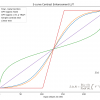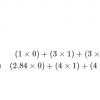
Привет! На днях ко мне обратился ученик на одном из ресурсов, где я выступаю в качестве frontend-ментора, с просьбой разобрать одну задачу. Суть задачи состояла в следующем:
Найти все доступные комбинаций предложений, полученных методом T9 (predictive text)
Вводные данные:
Файл input.txt, в котором описаны последовательности цифр, имитирующие пользовательский ввод:
48 26624637 843 476877 63 5388377 66 3224 74663 539 9484 2 3278 222377 3428466279 63 96737
48 56657 87 46 843 3428466279 255 96737 2677377663464 86 843 73783623 63 5397876537 263 673377 8436 29 373783629 63 873
2 26678837 47 2 776472662253 6224463 8428 73234837 46788 786737 263 62647852837 3282 263 77684337 688788 46 2 873385 367628
2 644486273 47 2 37326 8428 226 22873 2 787664 63428483 366846625 73776673 3766 843 7533737 897422559 3327 67 467767
746784263 47 26 22273842833 79626542 9748464 638463 8428 462732737 77333 67 2738489 63 9748464 27 26672733 86 2 667625 638463 63 9748464 2 52648243
843 7762377 63 9748464 46 746784263 47 225533 78366472749
843 8376 625664 47 622274662559 8733 86 73337 86 2 666 778273 732826453Файл dictionary.txt, в котором представлен список английских слов, который используется для предсказания заданного слова из последовательности выше.
Выходные данные:
Файл output.txt, в котором собраны все возможные варианты предложений.
Разбор задачи
Первое, что приходит на ум, так это использовать префиксные деревья. Давайте так и поступим. Для этого в начале нам понадобится определить карту соответствия букв цифрам в раскладке клавиатуры кнопочного телефона:
Маппинг
export const keyMap: Record<string, number> = {
a: 2,
b: 2,
c: 2,
d: 3,
e: 3,
f: 3,
g: 4,
h: 4,
i: 4,
j: 5,
k: 5,
l: 5,
m: 6,
n: 6,
o: 6,
p: 7,
q: 7,
r: 7,
s: 7,
t: 8,
u: 8,
v: 8,
w: 9,
x: 9,
y: 9,
z: 9,
};Далее приступим к реализации непосредственно префиксного дерева. Для этих целей заведем класс Trie, который реализует два основных метода insert и getPredictions. Здесь вставка работает путем обхода дерева в соответствии со строкой, которая должна быть вставлена, а затем в суффикс строки добавляются новые узлы, не содержащиеся в дереве:
Код класса
import { keyMap, rootGenerator } from "./helpers";
import { Root, Prediction } from './interfaces';
class Trie {
root: Root;
constructor() {
this.root = rootGenerator();
}
insert(word: string): void {
if (word.length === 0) throw new Error("A word has to be specified");
let currentNode = this.root;
Array.from(word).forEach((letter, index) => {
const digit = keyMap[letter];
let isLastNode = false;
if (word.length === index + 1) isLastNode = true;
if (!digit) throw new Error("Not a valid digit");
if (!currentNode.children) currentNode.children = {};
if (!currentNode.children[digit]) currentNode.children[digit] = rootGenerator();
currentNode = currentNode.children[digit] as Root;
if (!isLastNode) currentNode.predictions.deep.push(word);
});
currentNode.predictions.current.push(word);
}
getPredictions(keyString: string): Prediction | undefined {
const state = rootGenerator().predictions;
let currentNode = this.root;
let predictions;
Array.from(keyString).forEach((nodeKey) => {
if (!currentNode.children || !currentNode.children[nodeKey]) {
predictions = state;
return;
}
currentNode = currentNode.children[nodeKey] as Root;
predictions = currentNode.predictions;
});
return predictions;
}
}
export default Trie;Теперь реализуем класс для заполнения дерева и парсинга словаря. Тут нет каких-то уникальных моментов, поэтому без комментариев.
Парсинг
import { readFileSync } from "fs";
import Trie from "./trie";
import { rootGenerator } from "./helpers";
import { Prediction } from "./interfaces";
class TrieParser {
trie: Trie;
filePath: string;
constructor(filePath: string) {
this.trie = new Trie();
this.filePath = filePath;
}
createTrie(words?: string[]): void {
const wordArray = words || this.parseDictionary();
// Creating trie from words array
wordArray.forEach((word) => {
this.trie.insert(word);
});
}
parseDictionary(): string[] {
const filePath = this.filePath;
const data = readFileSync(filePath, {
encoding: "utf8",
});
const regex = /r?n/;
const array = data.toString().split(regex);
return array;
}
getPredictions(keyString: string): Prediction | undefined {
if (!keyString) return rootGenerator().predictions;
return this.trie.getPredictions(keyString);
}
}
export default TrieParser;Дело за малым — определиться, каким образом можно получить списки всех доступных комбинаций. Классический подход к генерации таких списков — алгоритм кучи, однако в нашем случае он не подходит, потому что мы хотим получить только уникальные варианты, а поэтому наиболее подходящий вариант — декартово произведение, реализация которого будет выглядеть следующим образом:
export function cartesian<T>(...words: T[][]): T[][] {
// iteratively get the cartesian product
return words.reduce<T[][]>(
// part - cartesian product of the first few arrays from words
(part, array) =>
part.flatMap((cartesianPart) =>
//cartesianPart is an array-prefix of one of the elements of the cartesian product
array.map((element) => [...cartesianPart, element])
),
[[]]
);
}На этом самая сложная часть заканчивается, и осталось только вызвать реализованные методы. Код с комментариями находится ниже:
Финальный листинг
import { readFileSync, createWriteStream, unlinkSync, existsSync } from "fs";
import { cartesian } from "./utils/cartesian";
import TrieParser from "./trie/trie-parser.js";
const dictionaryFilePath = "src/data/dictionary.txt";
const combinationsFilePath = "src/data/combinations.txt";
const outputFilePath = "src/data/output.txt";
const trieDictionaryInstance = new TrieParser(dictionaryFilePath);
trieDictionaryInstance.createTrie();
export function main() {
try {
if (existsSync(outputFilePath)) unlinkSync(outputFilePath);
// create file stream
const output = createWriteStream(outputFilePath, {
flags: "a",
});
const rawData = readFileSync(combinationsFilePath, { encoding: "utf-8" })
.toString()
.split(/r?n/);
for (const rawCombination of rawData) {
const combinations = rawCombination.split(" ");
const predictionArray: string[][] = combinations.map((combination) => {
// Get predictions for each combination in the string
const result = trieDictionaryInstance.getPredictions(combination);
const targetArray = result?.current.flatMap((item) =>
Array.isArray(item) ? item : [item]
);
return targetArray;
}) as string[][];
// Get cartesian products
const possibleProducts = (
[...cartesian(...(predictionArray as [string[]]))] as string[][]
).map((permutation) => permutation.join(" "));
for (const permutation of possibleProducts) {
output.write(permutation + "r");
}
}
output.end();
} catch (e) {
console.error(e);
}
}
main();Код задачи доступен на гитхаб. Спасибо за внимание!
Автор:
eyudinkov






